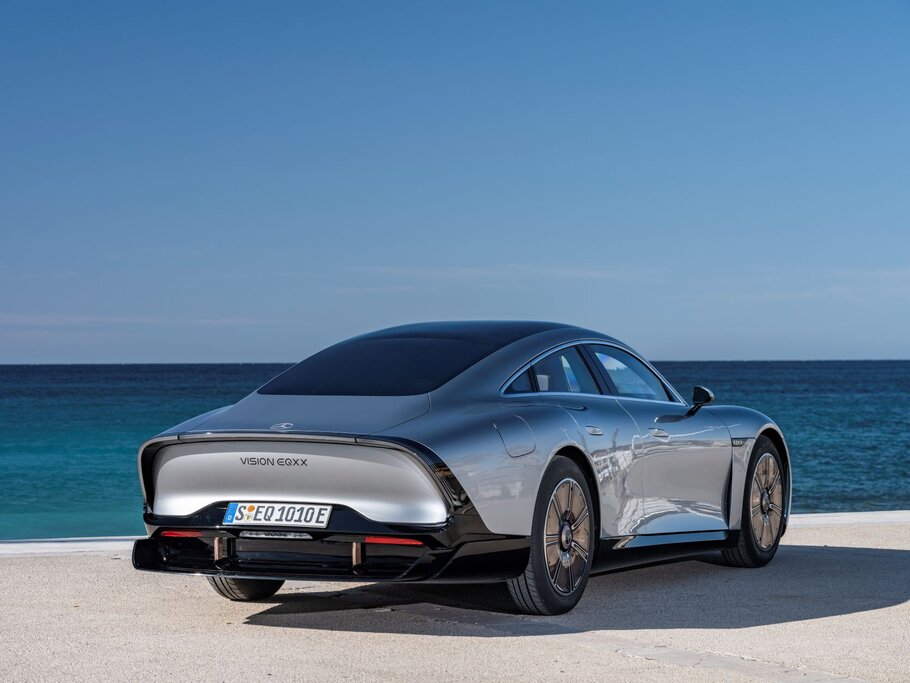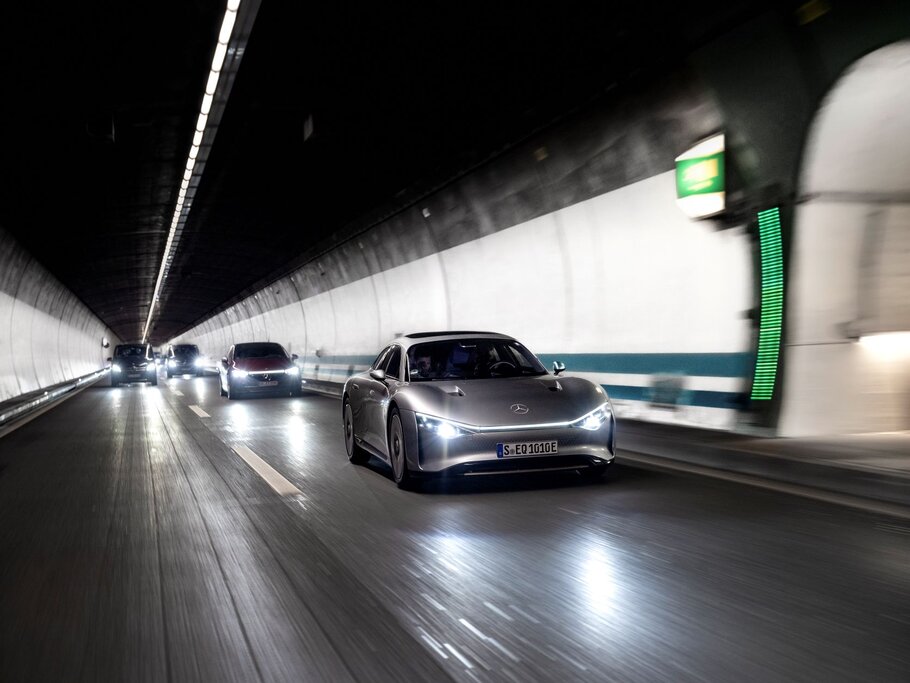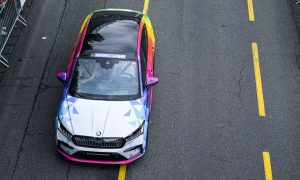
The VISION EQXX from Mercedes-Benz has now taken to the roads of Europe and has demonstrated its outstanding range and efficiency. Travelling from Sindelfingen across the Swiss Alps and Northern Italy, to its destination of Cassis on the Côte d’Azur, it effortlessly covered more than 1,000 km in everyday traffic, on a single battery charge. The journey started in cold and rainy conditions, and was undertaken at regular road speeds, including prolonged fast-lane cruising at up to 140 km/h on the German autobahn and near the speed limit elsewhere. The battery’s state of charge on arrival was around 15 percent, amounting to a remaining range of around 140 kilometres, and the average consumption was a record-breaking low of 8.7 kWh per 100 kilometres.
The VISION EQXX has thus taken electric vehicle efficiency to a whole new level – in real-life conditions and with independent proof. The long-distance drive was completed with the charging socket sealed and accompanied by an independent expert from certification body TÜV Süd. This officially confirms the effectiveness of the new Mercedes-Benz development approach – thinking holistically about efficiency from the drivetrain to aerodynamics and beyond, down to the tiniest detail, as well as working with even greater interfunctional collaboration and with external partners. This new blueprint for automotive engineering has delivered a new benchmark for electric vehicle efficiency and range, and the technology in the VISION EQXX will be deployed in upcoming series-production Mercedes vehicles.
“We did it! Powering through more than 1,000 kilometres with ease on a single battery charge and a consumption of only 8.7 kWh/100 km in real-world traffic conditions. The VISION EQXX is the most efficient Mercedes ever built. The technology programme behind it marks a milestone in the development of electric vehicles. It underpins our strategic aim to ‘Lead in Electric’,” says Ola Källenius, Chairman of the Board of Management of Mercedes-Benz Group AG.
Ready for the longest road trip since the invention of electric mobility
There’s a reason why road trips have been a cultural touchstone for decades, telling stories from the highway in books, movies and music. The road trip defines freedom, individuality, the very spirit of the automobile and the passing world. Stick a pin in the map – and drive.
The journey to electric mobility is also a road trip; as exhilarating as it is challenging, as unknown as it is certain. For Mercedes-Benz, it is a journey with a clear goal – maximum efficiency through innovation. The VISION EQXX is the product of a holistic approach with innovations in all technical areas that have an impact on energy consumption. “With our successful road trip to the South of France, we’ve shown that efficiency is the new currency. And this success also clearly speaks for our new collaborative development process, incorporating many learnings from the Mercedes-AMG F1 team and its cutting-edge expertise in electric powertrains. The VISION EQXX is the result of a comprehensive programme that provides a blueprint for the future of automotive engineering. Many of the innovative developments are already being integrated into production, some of them in the next generation of modular architecture for compact and midsize Mercedes‑Benz vehicles. And the journey continues. With the VISION EQXX, we will keep testing the limits of what’s possible,” says Markus Schäfer, Member of the Board of Management of Mercedes-Benz Group AG, Chief Technology Officer responsible for Development and Purchasing.
Challenging route profile and varying weather conditions
The VISION EQXX is packed with innovations. This software-defined research prototype is part of a far-reaching technology programme that combines the latest digital technology with Mercedes’ pioneering spirit, the agility of a start-up and the speed of Formula 1. The mission in developing the VISION EQXX was to break through technological barriers across the board. To show what is electrically “feasible”, the research vehicle completed a one-day road trip across several European borders: from Germany to Switzerland, on to Italy, past Milan and finally to its destination, the port town of Cassis near Marseille in the South of France.
The route profile – from motorway to mountain passes, including roadworks – and the weather conditions presented the VISION EQXX with a wide variety of challenges. Departing from the Sindelfingen R&D centre near Stuttgart in cold conditions, temperatures from start to finish ranged from 3 to 18 degrees Celsius. North of the Alps there was light rain and further south a gentle headwind blew in the sunshine. The various sections of the route helped document the effect of the many efficiency measures.
An excerpt from the trip log:
Up to 140 km/h on the motorway – low drag and rolling resistance pay off
The first leg from Sindelfingen to the north-eastern border of Switzerland runs along Autobahn 81. At times, the VISION EQXX sliced through the wind at speeds of up to 140 km/h. With its low cd value of 0.17, it gives the wind virtually nothing to grab hold of. This world-beating figure for a road-legal vehicle results from the intelligent interaction of many individual measures. It starts with the basic shape of the body, cradling the smooth-surfaced dome of the greenhouse as it flows elegantly like a water droplet towards the rear. Equally beneficial to the aerodynamics are the small frontal area of 2.12 m² and the reduced rear track. Because this is 50 mm narrower than at the front, the rear wheels roll in the slipstream of the front wheels. The active rear diffuser, which automatically deploys at 60 km/h, provides better airflow and thus contributes significantly to the reduced drag.
The technology vehicle gains further efficiency benefits from its tyres, with their extremely low rolling-resistance rating of 4.7. Bridgestone developed these specifically for the VISION EQXX in partnership with Mercedes-Benz. By way of comparison, the current EU tyre label requires a figure of 6.5 for the top rating in Class A. The EQS uses tyres with a rolling resistance of 5.9, which is significantly lower. With the VISION EQXX, Mercedes-Benz is now going one step further. A striking feature is the size of the new tyres. The dimensions 185/65 R 20 97 T mean they have a large diameter and a narrow tread. The specialist Turanza Eco tyres combine two innovative Bridgestone technologies that enable a higher range: ENLITEN technology reduces both rolling resistance and weight by up to 20 percent. The ologic technology reduces tyre deformation while driving, in part through a more tensioned belt section. In addition, the transition from the tyre to the wheel rim was optimised in cooperation with the Mercedes-Benz aerodynamics team.
Over the mountains – the lightweight dividend
The VISION EQXX’s special features also include its carefully thought-through lightweight construction, which has a particularly positive effect on uphill climbs. Any keen cyclist knows why it’s always the same kind of rider out in front on mountain stages. The heavier, more muscular sprinters are always staring at the taillights of the wiry featherweights on the uphill slogs. The decisive factor is the power-to-weight ratio. It’s not about sheer performance in the sense of “faster; higher; further” but about endurance and lower energy consumption.
This is exactly what the VISION EQXX demonstrates impressively on the approach to the Gotthard Tunnel heading for Italy. On the section between Amsteg and Göschenen, there’s a 14-kilometre uphill stretch with a gradient of up to five percent. It is here, where every gram of extra weight eats up energy, that the VISION EQXX scores sustainable points with its unladen weight of only 1,755 kilograms.
The lightweight design concept of the VISION EQXX is comprehensive – from the materials used to innovative bionic structures that deliver a favourable power-to-weight ratio. Examples of this are the sustainable carbon-fibre-sugar composite material used for the upper part of the battery, which is also used in Formula 1, and the BIONEQXXTM rear floor, manufactured using an aluminium casting process. The light metal structural component replaces a much heavier assembly of several interconnected parts. It has gaps in places where structural strength is not required, thus saving material. This innovative design approach results in a weight saving of up to 20 percent compared to a conventionally manufactured component.
A large part of the weight efficiency is also due to the dedicated electric chassis with lightweight F1 subframe and aluminium brake discs. Another is the battery. At 100 kWh, the power storage unit developed specifically for the VISION EQXX has almost the same amount of energy as the battery of the EQS, which is already a global benchmark among electric cars currently on the market. However, it has 50 percent less volume and is 30 percent lighter. The outcome is that the compact battery, measuring just 200 x 126 x 11 cm, is also comparatively light at 495 kilograms and fits in a compact car. The electric drive was developed in cooperation with the experts from Mercedes-AMG Petronas F1 Team.
Back down the hill – recuperation is the name of the game
After the Gotthard Tunnel, the road goes downhill for a very long way. This is where the VISION EQXX makes the most of the situation in its own way. While the golden rule of the professional cyclist is to go full throttle downhill to make up time, the VISION EQXX does the unthinkable and regenerates its energy reserves. In electric cars, this is called recuperation, the recovery of braking energy. In this discipline, too, the VISION EQXX sets new standards thanks to its highly efficient electric powertrain.
The VISION EQXX can use the recuperation effect on any type of gradient and during every braking manoeuvre, thus extending its range. A positive side effect of this electric braking is that the mechanical brakes are barely used. This makes it possible for the first time to use new types of aluminium brake discs that weigh significantly less than their steel counterparts.
Solar roof – energy snack in sunny Italy
The VISION EQXX gets a hearty energy snack around midday in the Po Valley near Milan – not at the charging station, but via its fixed solar roof. The 117 solar cells feed the 12-volt battery, which supplies power to auxiliary consumers such as the navigation system. The added value is measurable through the load this removes from the high-voltage battery, displayed by the onboard computer. Overall, the solar booster increases the range by more than two percent – which adds up to a good 25 kilometres on a journey of over 1,000 kilometres.
Innovative eATS – powerful, frugal, enduring
The electric drive unit in the VISION EQXX – consisting of the electric motor, transmission and power electronics – was developed together with the F1 specialists at HPP, and has a peak output of 180 kW. Thanks to the torque available from the first rev of the motor and the very low aerodynamic and rolling resistance of the VISION EQXX, its full potential is barely tapped during the entire trip. Much more important than top performance are other factors. Just like the battery, the electric drive unit is compact, lightweight and highly efficient. Its average efficiency in this application is 95%. That means 95% of the energy from the battery ends up at the wheels.
This goes hand-in-hand with further efficiency benefits such as the reduction of losses in the drivetrain. The engineers at Mercedes-Benz have succeeded in reducing the total losses in the drivetrain (motor, inverter and transmission) by 44% compared to an e-drive that is not based on this project. This makes a big different to the bottom line, with one percent more efficiency bringing two percent more range. This effect is further amplified by the battery of the VISION EQXX, thanks to its remarkable energy density of almost 400 Wh/l and particularly high operating voltage of more than 900 volts. And on the topic of high voltage: The VISION EQXX marks the first use of this technology, which proves itself throughout the entire journey. With not a single problem such as line overheating, everything is well under control. There are further efficiency from the active cell balancing. It ensures that energy is drawn evenly from the cells during the journey, which increases the usable energy and thus the range even more.
Efficient thermal management system – passive powertrain cooling is all it takes
Since the electric drivetrain generates little waste heat thanks to its high efficiency, passive cooling is sufficient throughout the journey. The cooling plate in the underbody uses the airflow to ensure even cooling. This aerodynamically highly efficient solution increases the range by 20 kilometres, while the cd value remains unchanged at a low 0.17.
Even on the ascent to the Gotthard Tunnel, the air shutters remain closed. The air control system would only open an additional airpath if there was an increased demand for cooling the electric drive or for climate control inside the cabin on hot days or if the heat pump was running on cold days. The airpath then connects the high-pressure zone at the front of the vehicle with the low-pressure zones along the top of the bonnet. This enables highly efficient thermal management with minimal air resistance. With the shutters open, the cd value would increase by only seven points (0.007).
Efficiency assistant – actively helping to save energy
Whether e-drive or combustion engine, the amount of energy a motor consumes in practice ultimately depends a great deal on driving style. In Switzerland, Italy and France, “pedal to the metal” is not an option anyway, thanks to speed limits and attentive law-enforcement officers. However, the VISION EQXX also proves to be an intelligent sidekick, assisting the driver like a co-pilot with tips on the best possible driving style. The efficiency assistant provides information on energy flow, battery status, topography and even the direction and intensity of wind and sun.
The UI/UX features an all-new, one-piece display that spans the entire width of the interior. Elements of the user interface support seamless interaction between the driver and the vehicle. These include Artificial Intelligence (AI) that mimics the way the human brain works. In the VISION EQXX, Mercedes-Benz takes a radically new UI/UX approach. A game engine takes UI graphics to a whole new level. The UI shows how real-time graphics open up new digital possibilities by reacting instantly to the driver’s needs and bringing the real world into the vehicle.
Finale in France – crossing the finish line with around 140 kilometres of remaining range
Shortly before crossing the finish line in Cassis, the VISION EQXX gathered energy once more through recuperation. After 11 hours and 32 minutes of driving time, it ended its 1,008-kilometre road trip with a remaining range of around 140 kilometres. This means it could have set off again for a jaunt along the Mediterranean coastline without recharging.
The VISION EQXX has unequivocally proven the real-world potential of outstanding efficiency for electric vehicles. This first road trip to Cassis is a watershed moment on a much bigger journey that is far from over. There’s a lot more to come.
VISION EQXX: the trip log in figures
|
Start |
Sindelfingen, April 5th, 2022, 7:00 a.m. |
|
Arrival |
Cassis, April 5th, 2022, 7:02 p.m. |
|
Travel route |
Sindelfingen, Gotthard Tunnel, Milan, Cassis |
|
Driving distance |
1,008 kilometres |
|
Total travel time/movement |
12 hours and 2 minutes/11 hours and 32 minutes |
|
Average speed |
87.4 km/h |
|
Maximum speed on motorway |
140 km/h |
|
Average consumption |
8.7 kWh per 100 km |
|
Battery charge level on arrival (SoC) |
around 15% |
|
Remaining range on arrival |
around 140 km |
VISION EQXX: the most important facts at a glance
#MissionAccomplished: more than 1,000 km with a single battery charge in real everyday traffic allows for relaxed long-distance journeys.
#EnergyWizard: efficiency-enhancing measures lead to an outstandingly low consumption of 8.7 kWh per 100 km.
#AeroChamp: outstanding work in aerodynamics and exterior design enables a benchmark drag coefficient of 0.17, which has a particularly positive effect on fuel consumption at high speeds on the motorway.
#RollingEfficiency: tyres with a significantly lower rolling resistance than the class A required by the EU tyre label and improved aerodynamic geometry, combined with lightweight magnesium wheels, provide more range.
#ElectricDrive: the radically new drive concept developed by Mercedes-Benz achieves a benchmark efficiency of 95% from battery to wheels.
#PassiveCooling: innovative passive drivetrain cooling via a cooling plate in the underbody.
#BionicEngineering: advanced digital tools enable innovative lightweight designs that increase efficiency and range.
#SolarPower: ultra-thin roof panels feed the battery system and provide up to 25 km of additional range.
#SoftwareDriven: software-driven approach is the key to success in achieving efficiency targets and a fast development process, including a sophisticated battery management system.
#GlobalResponsibleLeadership: with the VISION EQXX, Mercedes-Benz is stepping up the pace to “Lead in Electric” and “Lead in Car Software” and to set standards for sustainable mobility.
VISION EQXX: the most important technical data at a glance
|
Energy content of the battery |
kWh |
< 100 |
|
Rated voltage |
volts |
> 900 |
|
Energy consumption |
kWh/100 km |
8.7 |
|
Cd value |
|
0.17 |
|
Front face |
m² |
2.12 |
|
Power |
kW |
180 |
|
Wheelbase |
mm |
2,800 |
|
Length/width/height |
mm |
4,977/1,870/1,350 |
|
Unladen vehicle weight |
kg |
1,755 |





